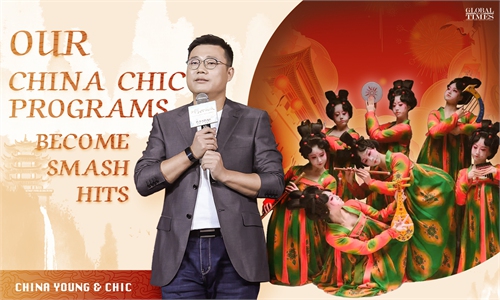ARTS / CULTURE & LEISURE
China Chic, youths’ choice for the future

Photo: Courtesy of Wang Xinman
The past decade has witnessed a surge in the popularity of Guochao, also known as the trend of "China Chic," among young Chinese consumers.A recent Big Data report, jointly issued by the People's Daily and search company Baidu, has revealed that the level of interest in China Chic has skyrocketed by 528 percent compared with a decade earlier. According to the Young Consumer Insights Survey into Guochao Brand released by Xinhua and an online shopping platform in 2022, 78.5 percent of consumers prefer Chinese brands, while the Post-1990 and Post-2000 generations have become the leading force in the consumption of the industry-wide China Chic brand field, accounting for 74 percent of total sales. Why has China Chic received such overwhelming support from millennials and Generation Z consumers in particular?
China Chic refers to fashion trends native to China, which incorporates unique native cultural elements into the latest trends. Combining a classical spirit, traditional aesthetics, current trends, and modern technology, China Chic products vibrantly convey China's cultural heritage and values, expressing national pride and confidence in the new era. The last few years have seen China Chic products prevail among the young generation, and we can analyze the reasons behind this phenomenon from the following perspectives.
At a macro level, favorable policies have supported the growth of China Chic brands. The 14th Five-Year Plan set the goal of building China into a country strong in culture by 2035. This indicates that China's cultural soft power will grow much more robust. Economically, China has become the world's second-largest economy. This substantial development has enhanced overall national strength, which boosts consumption capacity accordingly. Besides this, comprehensive improvements in technology, design, manufacturing, and marketing ensure competitive advantages in cost performance. Culturally, traditional culture is like a bridge that links history and the present and forms emotional ties among nationals. The China Chic trend is about the rise of domestic cultural symbols and the resurgence of fine tradition and cultural treasures. People convey their recognition of national identity and show their hopes and wishes for the future of the traditions through their support for China Chic products.
At a micro level, millennials and Generation Z, who have grown up in an era with a flourishing economy and culture, harbor a strong sense of national identity and have complete confidence and pride in national culture. They actively look for brands that align with the confident Chinese identity, and are eager to make Chinese culture better known and build a more fabulous national image for the rest of the world to see. Moreover, as an internet generation, they can access information and compare cultures in a broader view. Young people comprehensively understand the differences between international and local brands and make choices based on their evaluation. In addition, the new generation, born in an age of material abundance, tends to care more about spiritual fulfillment. Brands that can resonate, namely facilitate self-realization, are more likely to gain favor from this group. Unlike international brands, local ones like the China Chic group have an inherent advantage of "cultural resonance" in touching domestic consumers.
China Chic is not only a consumption boom related to designs and products. It reflects all aspects of the country and its future. The vitality of China Chic originates from its fusion of a classical spirit and modern innovation and traditional style meeting contemporary tastes, which satisfies younger consumers' need for pursuing personality and fashion and bringing back traditional culture. Domestically, China Chic promotes the integration of the real economy and digital economy and increases the added value of the manufacturing industry. Globally, China Chic, powered by culture and technology, mirrors China's economic, cultural, innovative strength and national confidence.
However, we should be aware of potential risks in advancing China Chic's development. For example, we need to avoid simply labeling products without considering inherent cultural connections, which would make them seem shallow or even ridiculous and cause them to disappear soon.
There are three tips for better growth of local brands in the long run. First, they must be rooted in but not restricted to traditional culture. China Chic design may incorporate historical and cultural elements with modern aesthetics to display fashion and tradition. For instance, the Bing Dwen Dwen and Shuey Rhon Rhon Olympic mascots were warmly welcomed by consumers because they serve as Chinese symbols. Second, China Chic may explore more cooperation with diverse regional cultures, which will form unique competitive edges and create more possibilities, like rural tourism development. Last but not least, China Chic should pay more attention to operations, especially marketing such as joint branding, thus bringing a more comprehensive experience to meet, orient, and stimulate consumers' needs.
Going far beyond merely jumping on the bandwagon, the young generation has every reason to be confident and rarely follows mindlessly. They lead our future and reshape business culture. China Chic is not only their expression of cultural confidence but their way of life as well.
The author is a faculty member with the School of Applied Economics, Renmin University of China. life@globaltimes.com.cn


